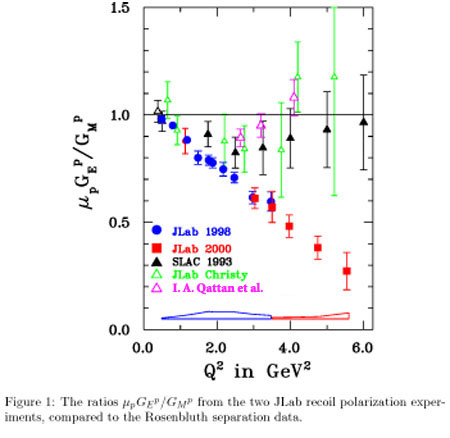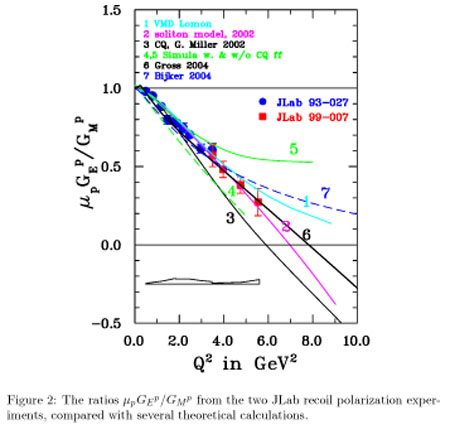Electric and Magnetic Elastic Proton Form Factors (GEp/GMp)
Additional Links

The ratios μpGEp/GMp from two JLab recoil polarization experiments, compared to the Rosenbluth separation data (left) and with several theoretical calculations (right).
Data from experiments measuring the ratio of the electric and magnetic elastic form factors of the proton, GEp/GMp, have shown an unexpected and significantly different dependence on the four-momentum transfer squared, Q2, for GEp than for GMp. This has been interpreted as indicating a difference between the spatial distributions of charge and magnetization at short distances. The results from two JLab experiments using the new polariztion transfer method were surprising, as they disagree with the ratios μpGEp/GMp, where μp is the proton magnetic moment, obtained by measuring cross sections (Rosenbluth method). The latter appear to be near unity up to about 6 GeV2, whereas the polarization results show a ratio value around 0.3 at Q2 of 5.6 GeV2.
The large discrepancy between the ratios obtained with the Rosenbluth and the recoil polarization method was confirmed by recent precision measurements of GEp/GMp in Hall A using the traditional Rosenbluth method. These demonstrated that the discrepancy is due to missing physics in the extraction of GEp/GMpfrom the data, rather than systematic problems in either data set. A likely explanation is the two-photon exchange process, which affects both cross section and polarization transfer components at the level of a few percent. However, because the Rosenbluth method is very sensitive to small variations in the angular dependence of the cross section, the two-photon effects have a much more dramatic impact on the results from Rosenbluth separation, while modifying the ratios obtained with the polarization method by a few percent only.
(See also Two-Photon Exchange entry in the Theory section
References:
M. K. Jones et al., Phys. Rev. Lett. 84 (2000) 1398
V. Punjabi et al., Phys. Rev. C 71 (2005) 055202
O. Gayou et al., Phys. Rev. Lett. 88 (2002) 092301
I.A. Qattan et al., Phys. Rev. Lett. 94 (2005) 142301


